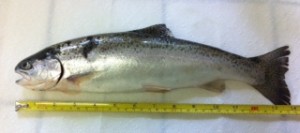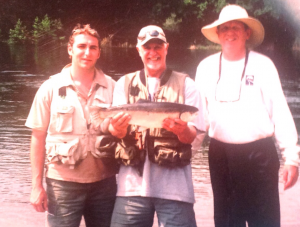 The 14-inch “half-pounder” hatchery steelhead in photo at right was caught in the lower American River in early March. It was likely one of 430 thousand stocked last June into the American River as fingerlings when Nimbus hatchery water was predicted to be too warm to sustain the fish through the summer. “Half pounder” is the name given to young steelhead that spend a few months in coastal waters before returning as premature adults to their natal rivers. This fish actually weighed about a pound. This “half-pounder” life history strategy is more frequent in North Coast steelhead, and may reflect the Eel River origin of the American River hatchery stock.
The 14-inch “half-pounder” hatchery steelhead in photo at right was caught in the lower American River in early March. It was likely one of 430 thousand stocked last June into the American River as fingerlings when Nimbus hatchery water was predicted to be too warm to sustain the fish through the summer. “Half pounder” is the name given to young steelhead that spend a few months in coastal waters before returning as premature adults to their natal rivers. This fish actually weighed about a pound. This “half-pounder” life history strategy is more frequent in North Coast steelhead, and may reflect the Eel River origin of the American River hatchery stock.
Other young hatchery steelhead from last June’s releases have remained in the river and are about 12 inches in length. These “smolts” have yet to go to ocean. If they had been released from the hatchery normally in February, they would only be about 8-10 inches (four to the pound). Instead, they flourished in the lower American, feasting on aquatic insects, salmon eggs and fry, and other abundant food. They are common throughout the upper 10-miles of river below salmon spawning riffles. Winter water temperatures (50-55F) and flows have been ideal for growth. Last summer’s water temperatures remained near optimal (<68F) all summer in the upper portion of the ten mile reach, while reaching 72-74F on occasion in the lower reach (USGS gage data). At one inch soon after birth, they have grownabout one inch per month, which is ideal for trout and yo ung steelhead.The native American River steelhead are “spring” run like the many larger fresh (bright) adults I have caught over the past two decades in the river from March-June. The bright steelhead at left was caught in June. Whether a remnant run or some genetic material remains in the population from these fish is unknown.
ung steelhead.The native American River steelhead are “spring” run like the many larger fresh (bright) adults I have caught over the past two decades in the river from March-June. The bright steelhead at left was caught in June. Whether a remnant run or some genetic material remains in the population from these fish is unknown.
The native Central Valley steelhead are also spring spawners as opposed to the present winter spawning stock, which tend to be in poor condition (often spent – already spawned) during the winter fishery. The spent hatchery fish in photo at right caught in early March near Nimbus Hatchery was in poor condition. With record low numbers of winter (Dec-Feb) steelhead reaching the hatchery this year , maybe it is time to rethink steelhead management on the lower American River.
With record low numbers of winter (Dec-Feb) steelhead reaching the hatchery this year , maybe it is time to rethink steelhead management on the lower American River.
Some suggestions follow:
- “The current broodstock for this program should be replaced with an alternative broodstock that is more appropriate for the American River.” California Hatchery Review Project – Appendix VIII Page 20 Nimbus Fish Hatchery Steelhead Program / June 2012 (http://cahatcheryreview.com). Being the only out-of-basin origin stock in the Central Valley, the present American River Hatchery stock is a threat to all native Central Valley steelhead populations (genetics). Given the very low population abundance of the American (Nimbus Hatchery) stock, this would be a good time to change (replace) the present genetic stock. This could be accomplished by designating the Nimbus Steelhead Hatchery as a “conservation hatchery” to be populated by “natural origin” fish from various sources including other Central Valley rivers, selected American River steelhead (e.g., spring run), or native American River trout from above Folsom Reservoir. This change could be implemented immediately.
- Hatchery releases in the immediate future could be of spring-early summer fingerlings, to allow natural adaptation and imprinting on the river. Yearling releases to the river should cease because yearling hatchery fish compete with and prey upon wild steelhead and salmon fry. If yearling releases are made, the smolts should be trucked to Discovery Park and then barged to the upper Bay.
- Wild, natural steelhead spawning and rearing habitat should be restored on the upper ten miles of river below Nimbus Dam. This would include restoration of side channel spawning and rearing habitat. It may also include a weir with a ladder in the middle of the 20-miles of the lower river to keep out competitors and predators including striped bass, smallmouth bass, tule perch, American shad, pikeminnow, and suckers. It must also include careful management of the cold water stored in Folsom Reservoir and flows in the lower American River .
- Catch-and-release fishing should continue on wild fish with limited harvest on hatchery fish.
- To ensure protection of the new “wild” or “natural” stock, a trap and haul program to establish a natural spawning and rearing population above Folsom Reservoir should be considered as recommended in the Central Valley Salmon and Steelhead Recovery Plan and OCAP Biological Opinion regarding operation of the Central Valley Project’s American River Division.
More on the American River and Central Valley steelhead in forthcoming posts.


 The 14-inch “half-pounder” hatchery steelhead in photo at right was caught in the lower American River in early March. It was likely one of 430 thousand stocked last June into the American River as fingerlings when Nimbus hatchery water was predicted to be too warm to sustain the fish through the summer. “Half pounder” is the name given to young steelhead that spend a few months in coastal waters before returning as premature adults to their natal rivers. This fish actually weighed about a pound. This “half-pounder” life history strategy is more frequent in North Coast steelhead, and may reflect the Eel River origin of the American River hatchery stock.
The 14-inch “half-pounder” hatchery steelhead in photo at right was caught in the lower American River in early March. It was likely one of 430 thousand stocked last June into the American River as fingerlings when Nimbus hatchery water was predicted to be too warm to sustain the fish through the summer. “Half pounder” is the name given to young steelhead that spend a few months in coastal waters before returning as premature adults to their natal rivers. This fish actually weighed about a pound. This “half-pounder” life history strategy is more frequent in North Coast steelhead, and may reflect the Eel River origin of the American River hatchery stock. ung steelhead.The native American River steelhead are “spring” run like the many larger fresh (bright) adults I have caught over the past two decades in the river from March-June. The bright steelhead at left was caught in June. Whether a remnant run or some genetic material remains in the population from these fish is unknown.
ung steelhead.The native American River steelhead are “spring” run like the many larger fresh (bright) adults I have caught over the past two decades in the river from March-June. The bright steelhead at left was caught in June. Whether a remnant run or some genetic material remains in the population from these fish is unknown. With record low numbers of winter (Dec-Feb) steelhead reaching the hatchery this year
With record low numbers of winter (Dec-Feb) steelhead reaching the hatchery this year